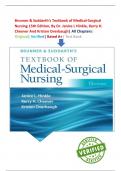Exam (elaborations)
Brunner & Suddarth's Textbook of Medical-Surgical Nursing 15th Edition, By Dr. Janice L Hinkle, Kerry H. Cheever And Kristen Overbaugh| All Chapters| Original| Verified| Rated A+| Test Bank
- Course
- Institution
- Book
Brunner & Suddarth's Textbook of Medical-Surgical Nursing 15th Edition, By Dr. Janice L Hinkle, Kerry H. Cheever And Kristen Overbaugh| All Chapters| Original| Verified| Rated A+| Test Bank TABLE OF CONTENTS Unit 1: principles of nursing practice Chapter 1: professional nursing practice Chapte...
[Show more]



